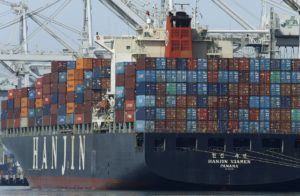 From furnishings – to financing – to in-bound foreign travel, the U.S. lodging industry is deeply, and happily entangled in a global marketplace. As the U.S. rescinds its participation in the Trans Pacific Partnership (an agreement which included 12 countries trading in the Asia Pacific region, accounting for a quarter of world trade), and talks about renegotiating NAFTA, hospitality purchasing agents and furnishing vendors all along the supply chain wonder about the impact of new international trade agreements on international sourcing of hospitality furniture.
From furnishings – to financing – to in-bound foreign travel, the U.S. lodging industry is deeply, and happily entangled in a global marketplace. As the U.S. rescinds its participation in the Trans Pacific Partnership (an agreement which included 12 countries trading in the Asia Pacific region, accounting for a quarter of world trade), and talks about renegotiating NAFTA, hospitality purchasing agents and furnishing vendors all along the supply chain wonder about the impact of new international trade agreements on international sourcing of hospitality furniture.
The short answer, of course, is that no one really knows. One thing is for sure. Hospitality is undeniably global by design.
In 2016, U.S. brands rapidly extended their global reach, especially into Asia. This was helped by brand consolidation such as the AccorHotels/Fairmont Raffles, HNA/Carlson and Marriott/Starwood transactions. Even while the brands moved east, offshore equity money came west. According to Jones Lang LaSalle’s January 2017 report on U.S. capital markets, there was $12 billion in offshore investment in U.S. hotel real estate in 2016; with $9 billion coming from mainland China. JLL’s report indicates that total offshore investment in U.S. hotels has increased almost 43% over the last five years.
Currently, approximately 70% of hospitality furnishings — casegoods, fabric, seating and lighting is produced offshore, with the majority coming from Asia.
We reached out to several vendors who manufacture in plants around the world for their opinion on whether domestic manufacturers can bridge the price gap – ramp up fast enough – and meet demand for hospitality FF&E in the U.S. While many agree this would be a positive scenario, few offer much hope it will be achieved – especially in the short term.
There are several strategic challenges facing U.S. furniture manufacturers:
Domestic furniture factories are already running at capacity.
One well-established carpet manufacturer has been running 3 shifts, 24 hours a day, 7 days a week for several months. This doesn’t leave time for routine maintenance and repair, which is a huge concern to the manufacturer and his clients, both of whom experience significant financial harm from even a slight schedule delay. Several domestic seating providers have dramatically expanded their production lines, and are still running at capacity. Domestic manufacturers already struggling with competitive global pricing pressure are understandably reluctant to risk investment in new U.S. plants and expanded capacity in what is typically a cyclical industry.
Lack of skilled and experienced tradespeople in the U.S. furniture industry is an ongoing challenge. Both line automation and custom finishes require specialized technical skills. Automation represents an emerging and ever-changing skill set; while custom hand finishing is something of a lost art.
Wages. Wages. Wages. One of our well-respected, long-established vendors provided typical monthly wages in U.S. dollars, including government mandated benefits, for a furniture factory worker in the various cities where they manufacture:
This wage survey clearly illustrates the basic economics of foreign vs domestic sourcing.
Competitive international shipping rates also help make it cost-effective for owners to source internationally, and put up with schedule extensions for time on the water. Interestingly, freight cost from Shanghai to a U.S. port is usually less expensive than the cost of ground transportation from Los Angeles to the Midwest.
New tariffs, duties and customs regulations may make it not only more expensive, but more difficult to expeditiously ship goods around the world. Changes in costs and lead times will require more careful planning by purchasing agents and ownership.
In all, this presents a complex and evolving situation for governments as well as for hotel owners and FF&E vendors. Current trade agreements, like the TPP, encompass far more than traditional tariffs, and strive to deal with key strategic issues facing international companies such as intellectual property, investment parameters, e-commerce, the environment, labor, competition and corruption. Politics, nationalism, and protectionism notwithstanding, it will be interesting to see how this all plays out not only in the U.S., but worldwide. The hospitality furnishings industry is a relatively small pond, and the ripples are felt immediately. We’ll keep you posted.
Above photo: Port of Oakland, Ben Margot/Associated Press